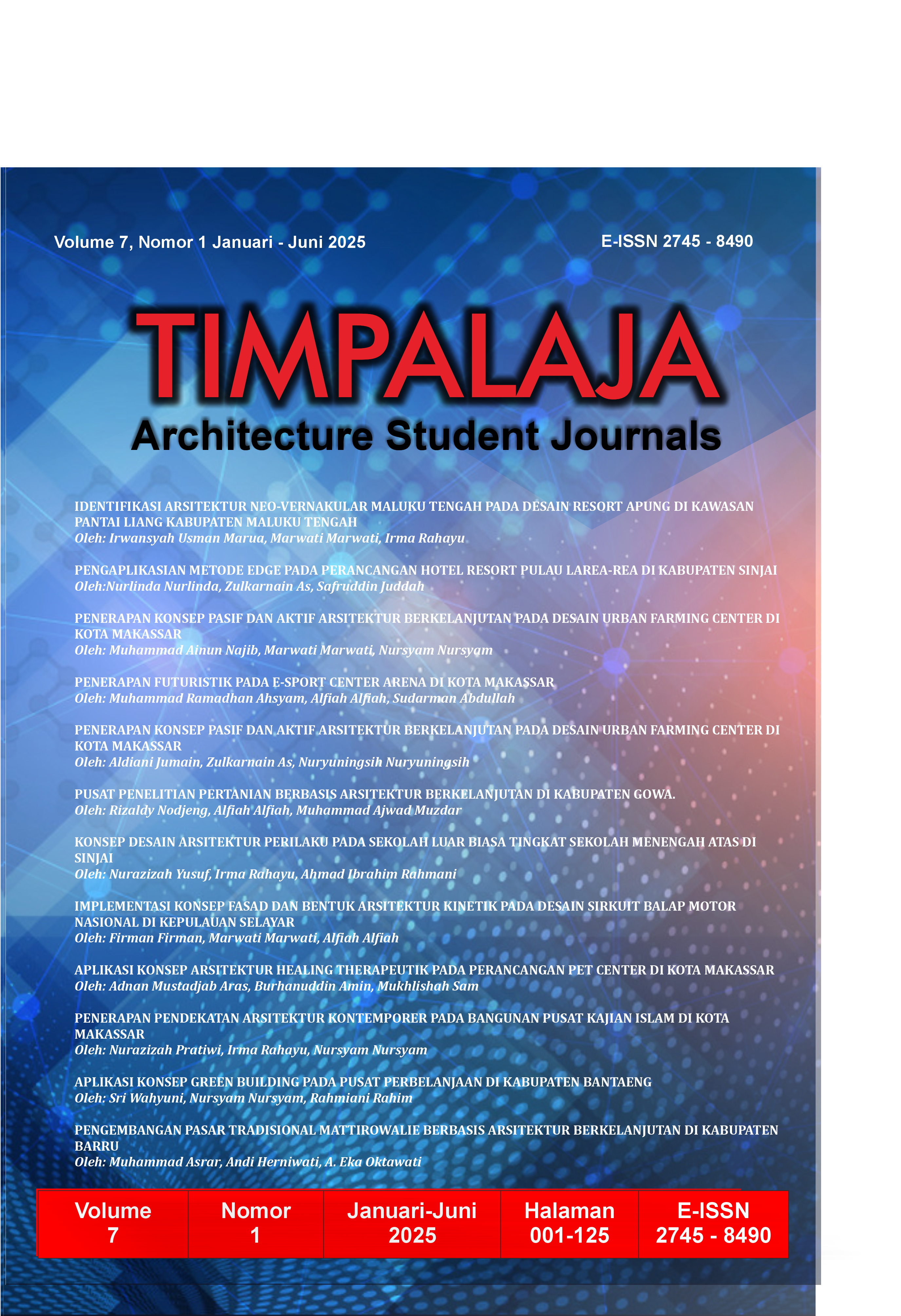Penerapan Arsitektur Organik pada Bangunan Wisata Kuliner Lokal di Kabupaten Enrekang
DOI:
https://doi.org/10.24252/timpalaja.v7i1a5Keywords:
Organic Architecture, Tourist Building, Local CulinaryAbstract
In the field of architecture, the concept of organic architecture emphasizes environmental aspects and harmony between a building and its site. The four main characteristics of organic architecture implementation are creating unique buildings that express their relationship with nature both externally and internally, selecting materials that align with their natural properties to create harmony with the surrounding environment, ensuring building elements blend well together, and the ability to communicate the time, place, and purpose of the design. This study aims to investigate the application of organic architecture in culinary tourism as a way to showcase regional uniqueness through distinctive local cuisine. The research methods include field data collection on physical environmental conditions, literature review on culinary tourism from books, journals, theses, and online sources, as well as examination of precedent buildings. Data analysis was conducted using descriptive techniques with reference to organic architecture planning and design guidelines. The findings indicate that applying organic architecture in culinary tourism can strengthen a region’s identity and uniqueness by offering local dishes prepared by the community. Therefore, culinary tourism based on organic architecture plays a significant role in enhancing the potential of unique local tourism.
References
Akbar, A. T., & Pangestuti, E. (2017). Peran Kuliner Dalam Meningkatkan Citra Destinasi Pariwisata Taman Nasional Bromo Tengger Semeru. In Jurnal Administrasi Bisnis (JAB)Vol (Vol. 50, Issue 1).
Alamsyah, Y. 2008. Bangkitnya Bisnis Kuliner Tradisional. Jakarta: PT. Elex Media Komputindo Kelompok Gramedia.
Fleming, John, Hugh Honour and Nikolaus Pevsner. (1999). The Penguin Dictionary of Architecture and Landscape Architecture. Inggris: Penguin Group.
Kautsar, Muthi Achadiat. 2018. “Food Tourism Rises as New Trend In Travel”. The Jakarta Post https://www.thejakartapost.com/life/2018/10/14/food-tourism-rises-as-new-trend-in- travel.html (23 December 2021)
Komaladewi, R., Mulyana, A., & Janika, D. (2017). Pemetaan Kuliner Lokal Dalam Menunjang Pariwisata Studi Di Bandung, Medan Dan Yogyakarta.
Permatasari, R. C., & Nugroho, Y. (2019). Kajian Desain Interior Ruang Tunggu Cip Lounge Bandara Di Indonesia. Aksen, 4(1), 18–37. https://doi.org/10.37715/aksen.v4i1.103 2
Rasikha, T. N. G. (2009). Arsitektur Organik Kontemporer. Universitas Indonesia.
Ratnasari, K., Levyda, L., & Giyatmi, G. (2020). Wisata Kuliner Sebagai Penunjang Pariwisata Di Pulau Belitung. Jurnal Pariwisata Pesona, 5(2), 93–106.
Saleh, Zulkarnain. (2011). Wisata Kuliner Di Pantai Barombong Makassar. Skripsi Sarjana, Fakultas Sains dan Teknologi Universitas Islam Negri Alauddin Makassar.
Suhamdani Hidri, H. (2010). Analisis pengembangan pariwisata alam Lewaja di Kabupaten Enrekang. Skripsi Sarjana, 3(2), 83–94.
Syarifuddin, D., Noor, C. M., & Rohendi, A. (2018). Memaknai Kuliner Lokal Sebagai Daya Tarik Wisata Kota Bandung. In Jurnal Pengabdian Kepada Masyarakat (Vol. 1, Issue 1). http://ejournal.bsi.ac.id/ejurnal/index.php/abdimas
Widati, T (2014). Rumah Usonian Sebagai Penerapan Arsitektur Organik Frank Lloyd Wright. Jurnal Perspektif Arsitektur 9(2). Kalimatan Tengah: Universitas Palangka Raya.
Wright, Frank Lloyd; The Future of Architecture, New York, Horizon Press, 1963
Zhafran, N.A., & Rahadian, E.Y. (2021). Penerapan Arsitektur Organik Pada Perancangan Parahyangan Place Mall. Institute Teknologi Nasional, No.1
Downloads
Published
How to Cite
Issue
Section
License
Copyright (c) 2025 Aldiani Jumain, Zulkarnain AS, Nuryuningsih Nuryuningsih

This work is licensed under a Creative Commons Attribution-ShareAlike 4.0 International License.
By submitting your manuscript to our journal, you are following Copyright and License



















